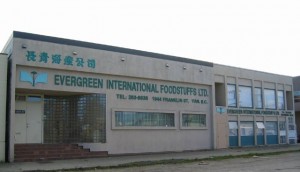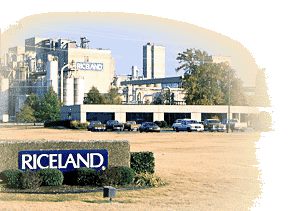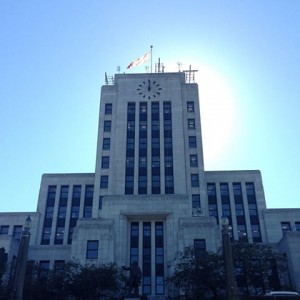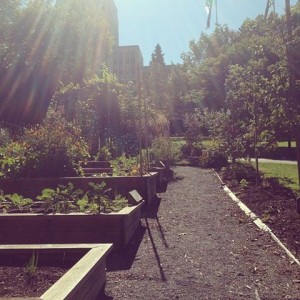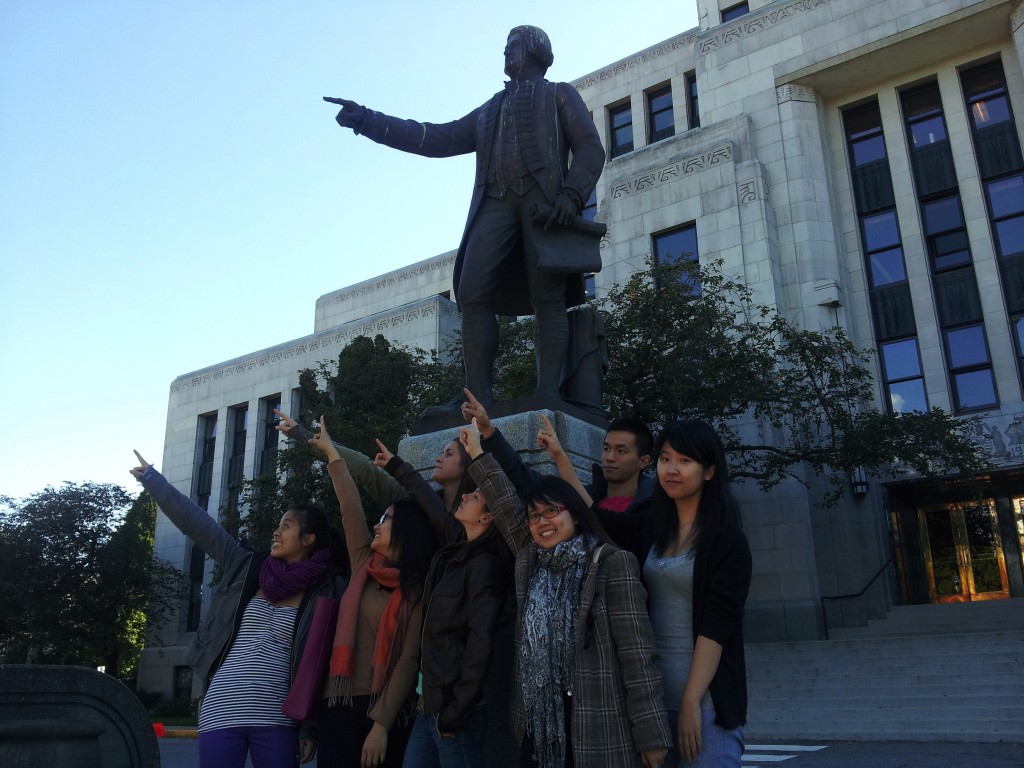Final Findings and Products
To answer our research question – “What is the current state of food recovery with food-providing businesses in Vancouver, and who are the potential receivers?” – we identified donors on big chain grocery stores, food processors, wholesalers/super centers, caterers, community gardens/farms and restaurants. For food recipients, we were interested in food banks, community kitchens, food runners and any other charitable meal-providing organizations. Within those parameters we were asked to find only the main locations.
After we developed a list of food donors and recipients and categorized each individual food donors and recipients as either currently or potential recovering food waste into tables (Appendix A), we used “Google Map Engine” application to visualize the locations of each donors and recipients as our subsequent method. We came out with 5 different maps: the overview of food recovery map including all donors and recipients, the donors 1 – grocery stores and wholesalers and supercenters, the donors 2 – food processors and farms and community gardens, the donors 3 – caterers and restaurants, and the recipients – food bank, food runners & non-profit meal provides, and community kitchens.
For each map we applied the same procedures. The overview map is a case of an example. Because one map could only do three layers, we did one layer for current donors, one for potential donors and one for recipients. Then, we clicked on the title of category and inserted each address to search area. After the marker showed the location we entered, we added to the category and edited the description (adding the name and address). Under the recipients’ category, we clicked on the “Data” and inserted a column for status to subdivide the potential and currents ones. In the end, we clicked on the “Style” for different styles of markers for easy identification.
For the first overview map (Appendix B, figure 1.), although there were not much the current donors and recipients, there were the opportunities for the potential ones to occur. Based on the map, the donors and recipients were close to each other, and most of them located at the downtown and urban area of Vancouver. Second, the donors 1 map (figure 2.) contained the most current donors which were even more than the potential ones. We were surprised that they actually distributed quite evenly in Vancouver except the rural area. Most the big chain grocery stores and supercenters with long history contributed the most current food recovery system in Vancouver. Third, the donors 2 map (figure 3.) had non-current food donors. Most food processors were located at the E. Vancouver, most farms located at the rural area of Vancouver, and most community gardens located at the urban area of Vancouver. Fourth, the donors 3 map (figure 4.) had only three current donors of caterers. Surprisingly, there was none for the restaurants although some of them were quite long history in Vancouver. There was abundance of potential opportunities of caterers and restaurants at the downtown area and along Broadway. Due to limited space to show in the table (Appendix B), we included more locations in the Donors 2 and 3 maps. Fifth, there were only four “current” recipients able to show on the recipients map (figure 5.) and the “Community Angel Food Runners” was done by mobile throughout Vancouver. We couldn’t find any program ran over the Granville St., all the current recipients were located at the E. Vancouver, and the potential recipients were mainly at the downtown region and E. Vancouver area.
Discussion:
In order for us to accurately interpret our results, we had to overcome the challenge of distinguishing between general donors and recipients and those donors and recipients that contribute to food recovery. We had to clearly define donors and recipients in the strict context of food recovery. For the purposes of our project, a business can only be considered a current donor if it is donating food that would otherwise be thrown out. Some companies donate foods that they otherwise would have actually sold to customers, or make cash donations to food-providing organizations. While such donations are definitely important and appreciated, they do not directly contribute to food recovery. Along the same lines, we must define recipients strictly as those organizations that are receiving foods that would otherwise have been thrown out. This was especially tricky regarding food banks. We discovered that the majority of food received by food banks is not food that would have otherwise been thrown out. Therefore, for our purposes we cannot technically consider them “current recipients”. The exception being the Greater Vancouver Food Bank Society, because they run programs that do receive recovered food and because they receive food from grocery stores that would have been discarded due to high standards and strict policy surrounding the food they are able to sell.
We also had to keep in mind that there are significant information gaps in our data. We had expected that it would be difficult to identify which potential donors are actually currently involved in food recovery and to what extent, due to businesses not wishing to disclose their practices, which it was. But what we didn’t expect was how difficult it would be to find details about the food being donated. Many recipients were unable to disclose any information regarding their donation sources or the amount, quality and type of food they receive.
Despite these information gaps, some connections can be made; our findings show that ample opportunity for food recovery exists in Vancouver. Geographically speaking, there are a significant number of potential donors and recipients in favourable proximity to each other, yet the two sides are not utilizing each other effectively. It is pretty clear that only a small percentage of the potential donors that we have identified are actually currently donating food that they would otherwise throw away. We can also see that a surprisingly large number of non-profit meal providers in Vancouver are not using recovered food. We discovered that most of them are instead contracting out private kitchens or purchasing food themselves, and of the ones that do rely on donations, many of them don’t use donated food exclusively. This shows us that location and physical logistics are not major barriers to food recovery in Vancouver. The barriers appear to be much more prominent in business practice and food policy regarding food safety and legal concerns; even with the implementation of the Good Samaritan Law, (which basically states that anyone who donates or distributes donated food is not liable for damages caused by the consumption of the food).
We also had to consider another limitation of our results: Just because food-providing businesses are not donating food to recipients doesn’t mean they aren’t practicing other methods of food recovery. But because our community partner was very clear that they were only interested in mapping Vancouver’s donors and receivers, our focus had to be on this one aspect. Therefore, our findings strictly reflect the donor/recipient channel of food recovery and it would be inaccurate for us to make any conclusions regarding the overall state of Vancouver’s food recovery system.
Our group members’ Reflections on this CBEL/Flexible Learning project:
Amanda – I am passionate about reducing food waste, so being presented with the opportunity to actually do something about it was really exciting for me. When we came out of our first meeting with our community partner, I was inspired and eager to dive into this project. I think that my expectations may have been a little too high, and I may have underestimated the time restraints. While I do think that this was a valuable experience, I was surprised and frustrated by the lack of information businesses and organizations were willing to share with us, especially by those who are actually contributing to food recovery, and I wish we could have made more of an impact on improving food recovery in Vancouver. I would like to continue to be involved in some capacity with the fight against food waste. I hope to incorporate it into my future dietetic career.
Diana – The CSL experience barely found in any other courses I am taking, but it’s a really important and valuable element that I think it should be implemented in every course. The CBEL project is like an adult and walking as me like its child in to the society to teach me how to utilize course material from lecture to the society so making the learning experiences more enjoyable and more accessible. This project allow me become the representative and presenters of our own project which enhanced my interest and improve my presentation skill. The blog posting in this project even forced me to be a blogger to consistently update my blog and learned how even become a blog administrator.
Eunice – My understanding of food security has been greatly enriched in this course through flexible learning. There are various approaches to the core concepts instead of simply sitting in the class listening to the lecture, which is different from any other courses I took before. The required reading articles and the E-lectures are so related to the project we have been working on, which lead us to critically apply the ideas presented to the real life situation. In addition, I enjoy the blog posting as a way to record our progress. When we look back at the end of the semester, we can see how we achieved our goal step by step and how our understanding and opinions get changed or developed. Overall, I really appreciate the experience to be involved in the CBEL project to fight against food waste, and to help promote food security.
Jill – This CBEL project brought my interest in reducing food waste and helped me to gain valuable and educative experience from my team, community partners, use of the blog, presentations and research skills. While watching the TED talk e-lecture of Tristram Stuart and meeting our community partners – City Studies and City of Vancouver, I felt enthusiastic and honour as being part of this project. However, after trying to identify the current and potential donors and recipients in Vancouver, we had limited information or resources of them. Due to the issues of food safety and responsibility, most donors were unwilling to declare or no response to food donation. Also, the food-recipients organizations were not allowed to provide any information of donors. If we have more time and resources, we could work more efficiently to fill in the gap and identify more donors and recipients.
Olivia – After having such diverse and flexible learning experiences, such as the e-lectures, utilizing a blog, and working with our community partners, I found it very difficult to go back to the lecture hall. The e-lectures and the blog allowed an enjoyable opportunity for reflection on my learning experiences, more so than I would leaving a lecture hall. During a lecture, one is more focuses on the time rather than the topic, whereas with these flexible learning experiences, one could choose when and where to take on this learning opportunity. From my experiences, when learning isn’t forced the impact on the person is greater. In addition, utilizing current methods such as TED talks, a blog, and socializing, rather than forcing old learning methods, allows students to lead the way in a social revolution.
Philip – Flexible learning (e-lectures, time allocated to work with community partners, and the use of blogs) allows students to engage with their school work on a more intimate level when compared to the traditional classroom setting with other courses offered at UBC. I personally loved the e-lectures because it connected class material and real life issues in a dramatic ‘Ted-like’ fashion. For example, ‘The global food waste scandal’ sparked a lot of my interest and really got me excited about doing this project with City Studio! In addition, the use of written proposals, proposal presentations and weekly blogs made our project much easier and enjoyable as those components were stepping stones that guided us to a better finished project.
Stephanie – While researching for this project, it definitely gave me a sense of hope towards the future of Vancouver’s food security. I felt like our group was able to fill some gaps and cover a lot of ground. Although we as a group felt that our work wasn’t too significant, we know that we did set a strong base for future advances in this project. In my opinion, CBEL and flexible learning go hand-in-hand. Both require us to actively reflect and analyze our experiences and it makes the course more memorable and meaningful. The common ground between the two is engagement. Throughout the course we are given ample opportunity to engage with our peers, the community, our faculty and the topics and that is the most beneficial method for the new generation of learning. It is those types of experiences that linger in the mind and don’t passively go in one ear and out the other.
Recommendations:
Based from our research, because the scope was very wide, we were able to cover a large area but our information did not have much depth. In order to make the findings more valuable, it would be beneficial to narrow down the size of scope, for example make a detailed map of one particular area. Another method could be to narrow down a particular type of donor (i.e just restaurants or grocery shops etc.) This would take several more successive groups/projects but the information would have much more depth and would serve to move the project along at a quicker pace towards food security of Vancouver.
From the CBEL experience, we truly understand what the city is trying to do and the amount of manpower they need to carry through with their project. If particular projects like ours had bigger groups or two groups assigned to a project it would allow us to cover more ground with the short time frame the course provides.
One of the ways that we think could improve food recovery in Vancouver would be helping our community partner set up partnership consultations. In other words, our ideal goal is to match the donors to the recipients. While most donors do not want to share their operation regarding food waste or do not have the interest, we could set up an environment that is safe and confidential to draw in locations to be potential donors. Another suggestion would be to organize mobile community workshops working its way throughout the city. These workshops would gather potential donors and even the public to educate or bring to light what constitutes “food waste” versus what can be recovered.
In terms of the CBEL agenda for this course, it would be a good opportunity have a presentation fair instead of a plenary presentation in which the groups and their community partners are given time to walk around to all the groups and really explore the topics of the other presentations. Our group felt that the presentation to the class was too short, and the class would better understand our project if we could showcase the entire amount of research we found, (all the types of donors and programs of recipients etc.), not constrained by time. In addition, for our project, it did not require community visits because of the scope of our project. It may be beneficial to create some sort of field work into all the projects. For example, in light of our project, we could have maybe job shadowed or spent a day at a donor or recipient’s location – to see the path food takes to get recovered.
If the projects have been finalized or community partners have informed you of interest in participating early on, the list of projects could be sent out prior to the start of the term, with links and descriptions so that students can research and possibly even choose their top three choices in preparation for the first class which then the formulation of the groups could happen as soon as possible and in turn it would leave more time to organize the flow of the projects or more time to do field work.
Group Message:
We do feel that our completed project will contribute to improving food recovery in Vancouver. Our work not only generated a comprehensive list that will give the City an accurate picture of the opportunities that exist, we were also able to determine where our efforts should be focused in our fight against food waste in Vancouver. Our findings are a clear indication that if we hope to improve food recovery on a large scale in Vancouver, we need to tackle business practice and food policy to erase the fear and hesitation surrounding safety and liability. In essence, we need to make it more appealing for businesses to recover food. From all we have learned this semester through e-lectures and readings, we understand the significant impact food recovery has on food security. Therefore by using this strategy to improve food recovery in Vancouver, we feel that we will ultimately help increase food security for Vancouver residents.
Appendix A:
*(The underlined “potential” donors and recipients are the ones that we able to confirm to not be currently involved in food donation. The un-underlined “potential” donors and recipients were either unable to comment on their food donation status or never replied to our contact efforts. All of the “current” donors and recipients have been confirmed.)
Table 1: Donors of Food Recovery Channel in Vancouver. Donors 1 (a) – Grocery Stores. Donors 1 (b) – Wholesaler and Super Centres.
Grocery Stores (a)
| Current | Potential |
| Buy Low Foods (370 E Broadway, Vancouver, BC V5T) | Donald’s Market (2279 Commercial Drive, Vancouver, B.C. V5N 4B6, 2342 East Hastings Street, Vancouver, BC V5L 1V5) |
| Marketplace IGA (2286 W Broadway, Vancouver, BC V6K 2E3) | Urban Fare (177 Davie Street, Vancouver, B.C., V6Z 2Y1, 305 Bute Street, Vancouver, B.C. V6C 3T6, 1133 Alberni Street, Vancouver, B.C., V6E 4T9, 1688 Salt Street, Vancouver, B.C., V5Y 0E4) |
| Choices Markets (2627 W 16th, Vancouver, BC V6K 3C2) | Nester’s Market (4475 Main Street, Vancouver, B.C., V5V 0A2, 333 Abbott Street, Vancouver, B.C., V6B 0G6, 990 Seymour Street, Vancouver, B.C., V6B 1B4) |
| PriceSmart Foods (2880 Bentall Street, Vancouver, BC V5M 4H4) | Greens Organic and Natural Market (1987 W. Broadway, Vancouver, B.C., V6J 1Z2) |
| Safeway (1641 Davie Street, Vancouver, BC V6G 1W1, 1766 Robson Street, Vancouver, BC V6G 2L6, 2315 W 4th Avenue, Vancouver, BC V6K 1P2, 2733 W Broadway, Vancouver, BC V6K 2G5, 4575 W 10th Avenue, Vancouver, BC V6R 2J1) | H-Mart (#200-590 Robson Street, Vancouver, B.C., V6B 2B7) |
| Save-on-Foods (2308 Cambie Street, Vancouver, BC V5Y 3W5) | Famous Foods (1595 Kingsway Street, Vancouver, B.C., V5N 2R8) |
| Super Valu (1645 E 1st Avenue, Vancouver, BC V5N 1A7) | |
| T & T Supermarket (2800 E 1st Avenue, Vancouver, BC V5M 4P3) | |
| Whole foods Market (510 West 8th Avenue, Vancouver, BC V5Z 1C5, 1675 Robson Street, Vancouver, BC V6G 1C8, 2285 W 4th Avenue, Vancouver, BC V6K 1N9) | |
| Kin’s Farm Market (#150-1160 Davie St., Vancouver, BC, V6E 1N1, 4516 W. 10th Ave., Vancouver, BC, V6R 2J1, #160-650 W. 41st Ave., Vancouver, BC, V5Z 2M9) |
Wholesalers and Super Centers (b)
| Current | Potential |
| Real Canadian Superstore (3185 Grandview Hwy, Vancouver, B.C. V5M 2E9, 350 S.E. Marine Dr., Vancouver, B.C. V5X 2S5) | Costco Warehouses (605 Expo Blvd, Vancouver, B.C. V6B 1V4) |
| Walmart Supercentres (3585 Grandview Hwy, Vancouver, B.C. V5M 2G8) |
Table 2: Donors of Food Recovery Channel in Vancouver. Donors 2 (a) – Food Processors. Donors 2 (b) – Farms and Community Gardens.
Food Processors (a)
| Current | Potential |
| Sunrise Soya Foods (729 Powell Street, Vancouver, B.C. V6A 1H5) | |
| Hallmark Poultry Processors Ltd. (1756 Pandora Street, Vancouver, B.C. V5L 1M1) | |
| Sofina Foods Inc. (8385 Fraser Street, Vancouver, B.C. V5X 3X8) | |
| Lantic Inc./Roger’s Sugar Ltd. (123 Rogers Street, Vancouver, B.C. V6A 3N2) | |
| Riceland (756 Prior Street, Vancouver, B.C. V6A 2E5) | |
| Daiya Foods (2768 Rupert Street, Vancouver, B.C. V5M 3T7) | |
| Evergreen International Foodstuffs Ltd. (1944 Franklin Street, Vancouver, B.C. V5L 1R2) |
Farms and Community Gardens (b)
| Current | Potential |
| Vanley Fresh Foods (McSpadden Park, Vancouver, B.C., V5N 5Y4) | |
| UBC Farm (3461 Ross Drive, Vancouver, B.C., V6T 1W5) | |
| Southlands Heritage Farm (6767 Balaclava Street, Vancouver, B.C., V6N 0A7) | |
| Solefood Urban Farm (399 Hawks Avenue, Vancouver, B.C., V6A) | |
| The World in a Garden (Multiple farms located between East and West Boulevard between 57th and 55th Avenue, Vancouver, B.C.) | |
| Cambie Community Garden (500 W. 54th Avenue, Vancouver, B.C., V6P 1L9) | |
| Strathcona Gardens (800 Prior Street, Vancouver, B.C., V6A 2G9) |
Table 3: Donors of Food Recovery Channel in Vancouver. Donors 3 (a) – Caterers. Donors 3 (b) – Restaurants.
Caterers (a)
| Current | Potential |
| Peake of Catering (4501 Main Street, Vancouver, B.C. V5V 3R4) | Savory Chef (826 Renfrew Street, Vancouver, B.C. V5K 4V6) |
| Out to Lunch (1175 Union Street, Vancouver, B.C. V6A 2C7) | Culinary Capers (1545 W. 3rd Avenue, Vancouver, B.C. V6J 1J8) |
| Potluck Café/Cat (30 W. Hastings St., Vancouver, B.C. V6B 1G4) | Emelle’s Catering (177 W. 7th Avenue, Vancouver, B.C. V5Y 1L8) |
| The Butler Did It Catering (620 Clarke Drive, Vancouver, B.C. V5L 3H8) | |
| Just Catering (1803 E. 1st Avenue, Vancouver, B.C. V5L 4B8) | |
| Just Right Catering (#106 950 Powell Street, Vancouver, B.C. V6A 1H9) | |
| Bread Garden (#103 950 Powell Street, Vancouver, B.C. V6A 1H9) |
Restaurants (b)
| Current | Potential |
| White Spot (1616 W. Georgia Street, Vancouver, B.C., V6G 2V5, 2850 Cambie Street, Vancouver, B.C., V5Z 2V5, 2518 W. Broadway, Vancouver, B.C., V6K 2G1, 1126 SE Marine Drive, Vancouver, B.C., V5X 2V7) | |
| Moxie`s Classic Grill (180 W. Georgia Street, Vancouver, B.C., V6B 4P4, 1160 Davie Street, Vancouver, B.C., V6E 1N2) | |
| Burgoo (3096 Main Street, Vancouver, B.C., V5T 3G5, 4434 W. 10th Avenue, Vancouver, B.C, V6R 2H8, 2272 W. 4th Avenue, Vancouver, B.C., V6K 1P2) | |
| Cactus Club (588 Burrard Street, Vancouver, B.C., V6C 0A8, 575 W. Broadway, Vancouver, B.C., V5Z 1E6, 357 Davie Street, Vancouver, B.C., V6B 1R2, 1790 Beach Avenue, Vancouver, B.C., V6E 1V3) | |
| Earls (1095 Mainland Street, Vancouver, B.C, V6B 5P9, 905 Hornby Street, Vancouver, B.C., V6Z 1V3, 1185 Robson Street, Vancouver, B.C., V6E 1V5, 1601 W. Broadway, Vancouver, B.C., V6J 1W9) | |
| Milestones (1109 Hamilton Street, Vancouver, B.C., V6B 5P6, 2425 Cambie Street, Vancouver, B.C., V5Z 4M5, 1145 Robson Street, Vancouver, B.C., V6E 1V5, 2966 W. 4th Avenue, V6K 1R4, 1210 Denman Street, Vancouver, B.C., V6G 2N2) | |
| Boston Pizza (1333 W. Broadway, Vancouver, B.C., V6H 4C1, 2850 Bentall Street, Vancouver, B.C., V5M 4H4) |
Table 4: Recipients of Food Recovery Channel in Vancouver. Recipients (a) – Food Banks. Recipients (b) – Food Runners and Non-Profit Meal Provides. Recipients (c) – Community Kitchens.
Food Banks (a)
| Current | Potential |
| Greater Vancouver Food Bank Society (1150 Raymur Avenue, Vancouver, B.C. V6A 3T2) | Mission Possible (543 Powell Street, Vancouver, B.C. V6A 1G8) |
| Refugee Food Bank Inland Refugee Society (#615 525 Seymour Street, Vancouver, B.C., V6B 3H7) | |
| Aids Vancouver (1107 Seymour Street, Vancouver, B.C., V6B 5S8) | |
| St. Paul’s Anglican Church (1130 Jervis Street, Vancouver, B.C., V6E 2C7) | |
| Healthiest Babies: Robert and Lily Lee Family Community Health Center (210 1669 E. Broadway, Vancouver, B.C., V5N 1V9) |
Food Runners and Non-Profit Meal Providers (b)
| Current | Potential |
| Community Angel Food Runners (Mobile, all throughout Vancouver)-Program of the Greater Vancouver Food Bank-Pick up food from donors (restaurants, hotels, cafeterias and schools) and deliver to meal-providing agencies throughout Greater Vancouver. | Meals on Wheels (Health and Home Care: 204-3077 Granville Street, Vancouver, B.C. V6H 3J9)-Provide isolated Vancouver and Richmond residents with hot meals, warm visits and informal checks on their safety.-Deliver meals every weekday at lunchtime. |
| Quest Food Exchange (611 East Hastings Street, Vancouver, B.C. V6A 1R2)-100% of food is donated from over 300 suppliers (wholesalers, grocery stores, restaurants and institutions).-3 different food programs (not-for-profit grocery markets, bulk orders and community training kitchen) that provide food for clients of hundreds of local social service agencies, as well as food for agencies to use for their own meal preparation. |
Community Kitchens (c)
| Current | Potential |
| Fresh Choice Kitchens (1150 Raymur Avenue, Vancouver, B.C. V6A 3T2)-Program of the Greater Vancouver Food Bank-Promotes independence for community kitchens by providing workshops and support | Crossroads Community Meal (1803 E. 1st Avenue, Vancouver, B.C., V5L 4B8)-Weekly participant-led community meal.-Accepts cash donations, but not currently receiving recovered food.
|
| Soul Kitchen (1515 Charles Street, Vancouver, B.C., V5L 2T2)-Program of More Than a Rooftop Foundation-Provide meals for less fortunate Vancouver residents |
Appendix B:
*(The darker markers are the current donors or recipients, and the lighter markers are the potential ones.)
Figure 1: Food Recovery Map Overview. All current and potential donors and recipients in Vancouver
.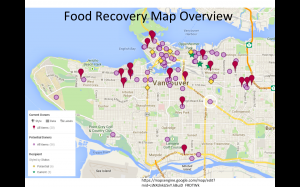 https://mapsengine.google.com/map/edit?mid=zjNXdnkJjSvY.kBujD_FRDTWk
https://mapsengine.google.com/map/edit?mid=zjNXdnkJjSvY.kBujD_FRDTWk
Figure 2: Map of Food Recovery Channel – Donors 1. The Current and Potential donors of Grocery Stores and Wholesalers and Super Centres. 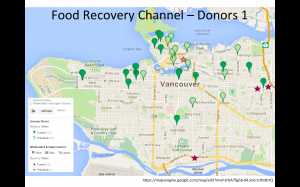 https://mapsengine.google.com/map/edit?mid=zHJA7fgGb-84.kdccVJXnBrtQ
https://mapsengine.google.com/map/edit?mid=zHJA7fgGb-84.kdccVJXnBrtQ
Figure 3: Map of Food Recovery Channel – Donors 2. The Current and Potential donors of Food Processors and Farms and Community Gardens.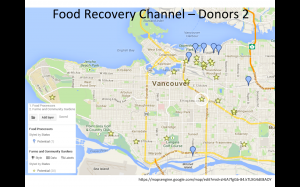 https://mapsengine.google.com/map/edit?mid=zHJA7fgGb-84.kTLXG4dE8AOY
https://mapsengine.google.com/map/edit?mid=zHJA7fgGb-84.kTLXG4dE8AOY
Figure 4: Map of Food Recovery Channel – Donors 3. The Current and Potential donors of Caterers and restaurants
.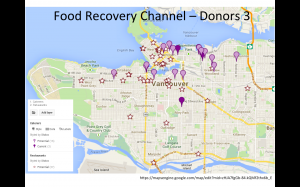 https://mapsengine.google.com/map/edit?mid=zHJA7fgGb-84.kQMf2thx6b_E
https://mapsengine.google.com/map/edit?mid=zHJA7fgGb-84.kQMf2thx6b_E
Figure 5: Map of Food Recovery Channel – Recipients. The Current and Potential recipients of Food Banks, Food Runners and Non-Profit Meal Providers, and Community Kitchens
.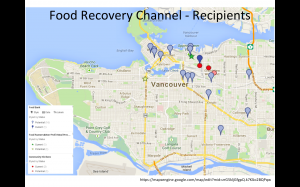 https://mapsengine.google.com/map/edit?mid=zrG5kljGfgpQ.k7KlJo2BQPqw
https://mapsengine.google.com/map/edit?mid=zrG5kljGfgpQ.k7KlJo2BQPqw

